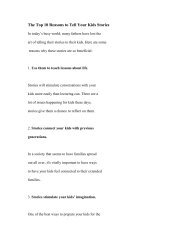Organic Chemistry
Chirality
Chirality
You also want an ePaper? Increase the reach of your titles
YUMPU automatically turns print PDFs into web optimized ePapers that Google loves.
<strong>Organic</strong> <strong>Chemistry</strong> - Ch 11 546 Daley & DaleyA chiral probe is atechnique that uses aninstrument or chemicalcompound todistinguish betweenindividualenantiomers. Thechiral probe must bechiral in some fashion.A polarimeter is aninstrument thatmeasures the numberof degrees a moleculeturns a plane ofpolarized light.An enzyme is a largechiral moleculeconsisting of chiralamino acids, such asserine (page 000), withchiral reactive sites.Most of the physical properties of both pure enantiomers areidentical. For example, both molecules have identical melting points,boiling points, densities, NMR, IR, MS, and indexes of refraction. Theydo differ, however, in two significant ways. 1) Both enantiomers of apair rotate a plane of polarized light and rotate it the same number ofdegrees, but they rotate the light in opposite directions: one clockwiseand the other counterclockwise. Thus, they are called optical isomers.2) Each enantiomer of a pair reacts in an individual way in anasymmetric chemical environment to form another asymmetriccompound. Because of their identical physical properties, the only wayto distinguish between enantiomers is by using a chiral probe.Polarimeters are chiral probes, as are chiral, or asymmetric,molecules.The two molecules in a pair of enantiomers react differentlyfrom each other with another asymmetric compound because of themolecular asymmetry of the pair of enantiomers. Reactions take placewhen two different molecules physically come in contact with eachother. Thus, their shapes determine how they fit together and how or,in some cases, whether or not they will react with each other.Your hands represent a very simplistic example of thisprinciple. As mentioned previously, your hands are chiral objects, solet them represent a pair of enantiomers. React that pair ofenantiomers with a symmetric compound, represented by a pair ofgreen flat mittens. Because both mittens will easily fit on either hand,they illustrate how two enantiomers react in the same way with asymmetric compound. Now suppose you react a pair of enantiomerswith a pair of asymmetric compounds represented by one red mittenand one green mitten. In this case, either mitten can fit on eitherhand, but the right hand wearing the green mitten is different thanwhen it is wearing the red mitten. There are four possiblecombinations with a red or green mitten on the left or right hands.To extend this example further, replace the mittens withgloves. In this case, the right glove fits only on your right hand, andthe left glove fits only on your left hand. An example of a glove-likecompound is an enzyme. Enzymes catalyze the reactions that takeplace within the cells of your body and in all other living organisms.Each enzyme is specifically shaped and fits only with thecorrespondingly shaped enantiomer making up the nutrients from thefood you eat, the medicines you take, or the hormones your bodyproduces. This situation is analogous to fitting your hand into a glove.Because the reaction takes place during the time the enzyme and theenantiomer are fitted together, the two won't react if they don't fit.SIDEBAR—Chiral Recognitionwww.ochem4free.com 5 July 2005







